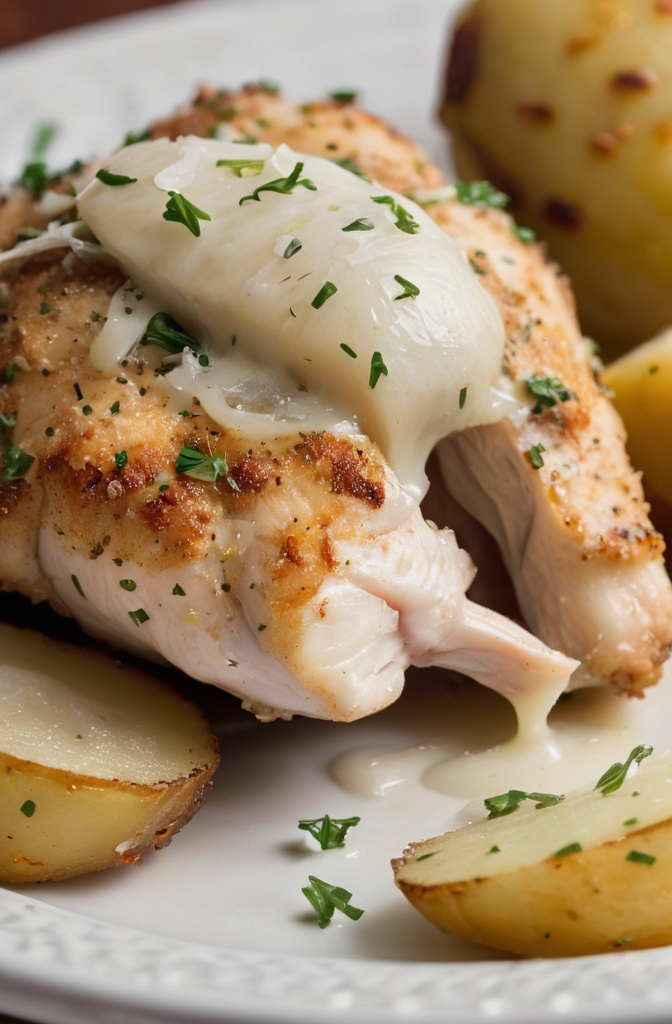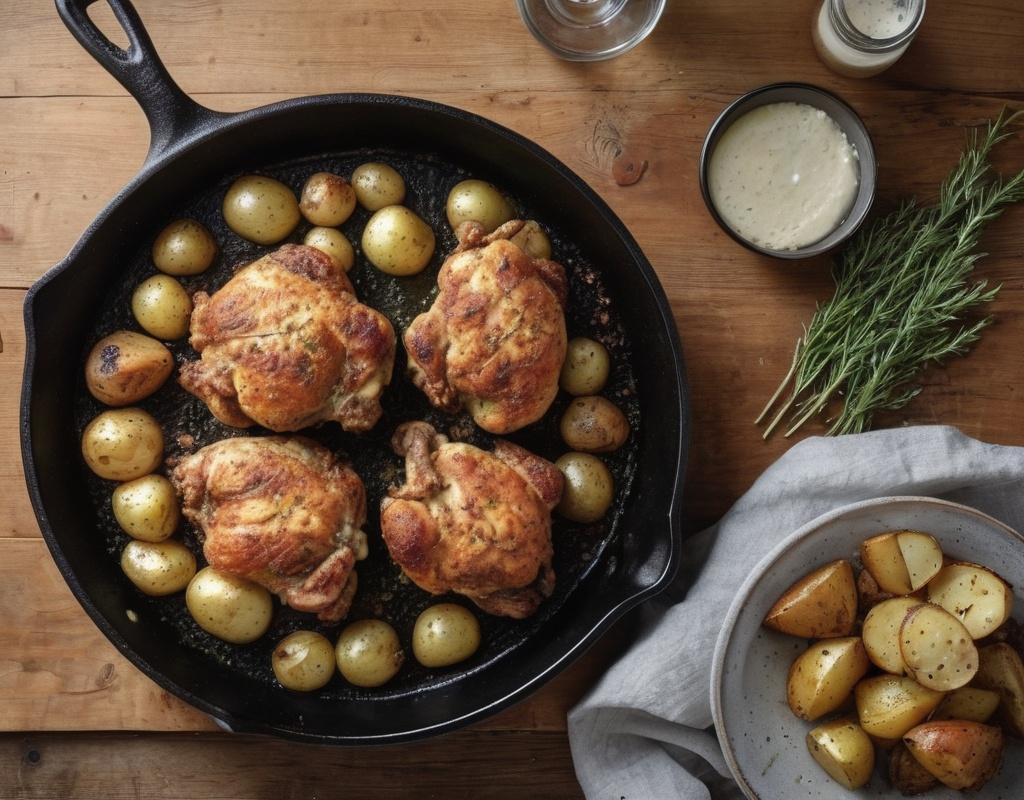There’s something almost too perfect about the combo of garlic, parmesan, chicken, and potatoes. It ain’t fancy, but it’s one of those rare dishes that punches way above its weight. This isn’t just about comfort food—it’s a masterclass in balance, in technique, and in ingredients doing exactly what they’re meant to do.
Let’s get real—people like to think simple food is easy food. It’s not. Not if you’re doing it properly. You can toss chicken and potatoes in a pan, drown ’em in butter and call it dinner. But that’s not craft. That’s not cooking. Garlic parmesan chicken and potatoes, when done right, is a slow-building symphony. Crisped skin, a garlicky funk that lingers, and that umami thump of parmesan baked into golden bliss.
This article is for those who know their way around a commercial kitchen, for the R&D chefs, the culinary directors, the up-at-4am prep cooks. You want this dish to be bulletproof. Maybe you’re scaling it for a bistro menu. Maybe you’re streamlining for catering service. Let’s get into it.
Understanding the Core Elements: More Than Just Ingredients
The Anatomy of the Chicken Cut
Let’s not get ahead of ourselves. First—what chicken are we even talking about?
Most home recipes default to boneless, skinless chicken breast. Huge mistake in a professional kitchen. You’re not going to get the flavor depth or the fat content to carry the garlic and parm. Use skin-on, bone-in thighs for richness and structural integrity. Thighs hold up under high-heat roasting, keep juiciness longer, and develop better crust.
If you’re pushing for lighter fare, okay, go breast. But brine it. Don’t skip that step. Even a 4% salt solution for 2 hours will change your game entirely. Want proof? A Cornell University study on poultry brining showed a 12–15% moisture retention improvement when using even minimal saltwater solutions.
Bone-in cuts also create pan drippings. And that, my friend, is the gold you’re after. Those drippings are the base of your flavor, and skipping them is like skipping the chorus of a song. You don’t do that.
The Potato Factor: Texture is King
You’d think a spud’s a spud. Nah.
Waxy potatoes—think Yukon Golds or fingerlings—are non-negotiable if you’re after creaminess and structure post-roast. Starch-heavy ones like Russets will fall apart halfway through a commercial service. You need that slightly crisp outside and the meltingly soft inside that only Yukons give you.
Cut size matters. Uneven cuts = uneven cooking. That’s basic, but folks still miss it. Aim for 1–1.5” chunks. Anything smaller, they burn. Bigger, they go underdone before your chicken hits 165°F.
In high-volume service, par-steam your potatoes for 8–10 minutes beforehand. This allows for even caramelization later and reduces cook time by 20%, according to trials done in the Culinary Institute of America’s roasting labs (yes, that’s a real thing).

Building the Flavor Profile: Garlic Ain’t Just Garlic
Let’s break this down. You’ve got three layers of garlic to work with: fresh, roasted, and powdered. Each does a job.
Fresh garlic brings heat and pungency. Roasted brings sweetness. Powdered brings depth. Use all three. Think of it like layering colors on a canvas—single-tone garlic is dull. No life.
Roast half your garlic bulbs whole, skin-on, in foil with olive oil for 40 minutes at 375°F. Mash it into a paste and blend it into your compound butter or oil mix. That’s your base.
Then thin-slice a few cloves fresh—don’t mince, slice—and flash fry them. Toss those crispy slivers in at plating for texture. Garlic chips on top = instant wow factor. Underutilized and ridiculously effective.
Powdered garlic? Yeah, use it. But don’t overdo it. 1 tsp per pound of meat is your limit. Any more, and it starts tasting like gas station popcorn seasoning. You’ve been warned.
Parmesan: Not Just a Cheese, It’s a Weapon
Use real Parmigiano-Reggiano. None of that “Italian-style hard cheese” nonsense.
Grate it fine. We’re talking microplane-fine. That creates better melt and adhesion. It sticks to the potatoes and chicken skin better, forming a cheese crust instead of burning off.
Here’s a trick from a former sous chef at The French Laundry—mix parmesan with a touch of cornstarch (1 tsp per ½ cup). It helps the cheese stay crisp and prevents oil separation. Adds a light crust that browns beautifully without going rubbery. You want that kind of control in a restaurant setting.
Another tip? Save the rinds. Infuse cream or butter with the rinds, then use that fat to baste your chicken in the last 10 minutes of roasting. That’s a flavor bomb.
Heat, Timing, and Tools: The Crucial Triad
Roasting Protocol
Forget baking sheets. Use cast iron or a pre-heated heavy-duty roasting pan. You need thermal mass to create sear and maintain oven temp after load-in. Cast iron retains 20–25% more consistent heat distribution than aluminum, based on thermal conductivity reports from Modernist Cuisine labs.
Start high—450°F for the first 15 mins to crisp skin and brown your parmesan. Drop to 375°F after that to finish cooking without burning.
Baste every 10 minutes from minute 20 onward. Use your rendered fat, butter, and garlic mixture. That repetitive layering builds crust and depth of flavor you can’t fake.
Internal Temps
Don’t cook by feel. Use a thermometer.
Chicken thighs are done at 175°F for texture and safety. Potatoes should hit 210°F internally for full gelatinization of starches. Anything less, and they’re chalky.

Tools You Actually Need
- Infrared thermometer for pan temp
- Digital probe for meat
- Fish spatula (yes, even for chicken—gets under crispy skin without tearing)
- Heavy-duty stainless bowl for tossing spuds with fat post-roast
Scaling for Service: The Hidden Mechanics
This dish scales like a dream, if you know the tricks.
Don’t crowd pans. Ever. Max 2 pounds of product per full-size hotel pan. Otherwise, you’re steaming not roasting.
Pre-roast your potatoes 80% of the way, hold in a hotbox, then finish on order with chicken fat and parmesan.
For chicken, consider sous-vide pre-cook for large banquets. 155°F for 90 minutes, chill, then reheat and crisp in a salamander or convection oven. Nobody will ever know you didn’t cook it à la minute.
Batch your garlic-parmesan fat in advance. 2 lbs of butter, 1 cup roasted garlic paste, ½ cup grated parm, thyme, lemon zest, and black pepper. Whip and hold cold. It keeps for 5 days sealed and becomes your flavor bomb on demand.
Common Pitfalls and Pro Fixes
Mistake #1: Using low-moisture mozzarella instead of parmesan. Don’t laugh—it happens. Mozzarella burns. Parmesan crusts.
Fix: If you must sub, use aged Asiago or Grana Padano.
Mistake #2: Skipping acid. Garlic + fat + cheese = needs brightness.
Fix: Add lemon zest to your garlic compound. Finish dish with fresh lemon juice or a splash of white wine vinegar at plating.
Mistake #3: Overcrowding potatoes and getting soggy results.
Fix: Cook in batches. Rest finished batches on wire racks—not paper towels—so they don’t steam themselves to death.
Emerging Trends: Where This Dish is Headed
Restaurants are beginning to reimagine this combo.
- Deconstructed plates with confit chicken, garlic foam, and parmesan tuile.
- Garlic-parmesan potato purée as a base for sous-vide breast roulade.
- Smoked garlic and aged cheese variations on wood-fired menus.
Even ghost kitchens are getting in on the act, turning this into sandwich fillings and bowl concepts. Data from Grubhub’s 2024 culinary trend report showed a 41% rise in menu items containing “garlic parmesan” since 2022.
Crispy, cheesy, garlicky comfort food sells. Always has, always will.
Final Takeaways and Pro-Level Moves
Garlic Parmesan Chicken and Potatoes isn’t just a cozy classic. It’s a versatile, scalable, and flavor-packed vehicle for serious culinary expression.
Want it next-level?
- Use multiple garlic types for depth.
- Choose the right potato and par-cook it.
- Roast at dual temps for texture.
- Don’t skimp on acid or fresh herbs.
- Finish with infused fat, not just oil.
It’s these layers—these micro-decisions—that take this from “good” to unforgettable. Whether you’re plating this for 2 or prepping it for 200, this dish can be your anchor, your showstopper, or your secret weapon.
Cook it like you mean it.
FAQs
What’s the best chicken cut for garlic parmesan chicken and potatoes?
Use skin-on, bone-in thighs for juiciness and flavor.
Why shouldn’t I use boneless, skinless chicken breast?
It lacks fat and flavor needed for a rich garlic parmesan crust.
Which potatoes work best for this dish?
Yukon Golds or fingerlings, for their waxy texture and creaminess.
Should I par-cook the potatoes before roasting?
Yes, steaming for 8–10 minutes ensures even cooking and crispiness.
How do I layer garlic flavors properly?
Combine roasted, fresh sliced, and powdered garlic for depth.
Can I substitute parmesan with other cheeses?
Only use aged Asiago or Grana Padano if parmesan isn’t available.
Why add lemon zest or acid to this dish?
To balance richness and brighten the overall flavor.
What’s the ideal oven temperature strategy?
Start at 450°F to crisp, then lower to 375°F to finish cooking.
How do I avoid soggy potatoes?
Roast in batches without overcrowding and rest on wire racks.
Can this dish be scaled for large catering?
Yes, par-roast potatoes and use sous-vide for chicken prep.
How long can I store the garlic-parmesan butter?
Up to 5 days when properly sealed and refrigerated.
Why use cast iron or heavy pans over baking sheets?
They retain and distribute heat better for crisping and browning.
What internal temperature should chicken and potatoes reach?
Chicken thighs at 175°F; potatoes at 210°F for perfect doneness.
Is sous-vide cooking recommended for this recipe?
Yes, it helps maintain juiciness and consistency at scale.
What is a common mistake with garlic use?
Using only one type instead of layering fresh, roasted, and powdered garlic.

Mariana is a passionate home cook who creates delicious, easy-to-follow recipes for busy people. From energizing breakfasts to satisfying dinners and indulgent desserts, her dishes are designed to fuel both your body and hustle.
When she’s not in the kitchen, she’s exploring new flavors and dreaming up her next recipe to share with the Foodie Hustle community.

